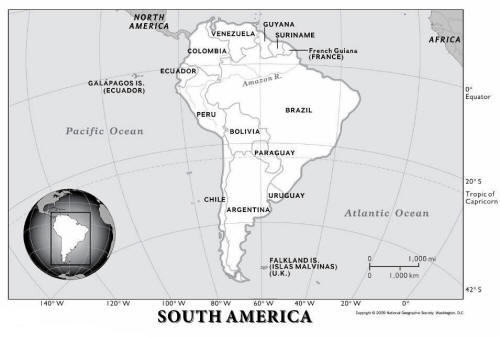
Stretching beneath
Argentina, Brazil, Paraguay, and Uruguay,
South America's Guaraní
Aquifer is larger than Texas and California combined.
Critics fear that the
United States is secretly taking over the underground reservoir.
But experts say the
conspiracy theorists are all wet
Conspiracy theorists fear the United States
is secretly taking control of South America's largest underground
reservoir of fresh water.
The accusations are clouding international
efforts to develop the Guaraní Aquifer. And the rumors come at a time
when water may be joining oil as one of the world's most fought-over
commodities (related:
"UN Highlights World Water Crisis"
- June 5, 2003.)
Stretching beneath parts of,
-
Argentina
-
Brazil
-
Paraguay
-
Uruguay,
...the Guaraní Aquifer is an underground system of
water-bearing rock layers covering 460,000 square miles (1.2 million square
kilometers) - an area larger than Texas and California combined.

The International Atomic Energy Agency says the
Guaraní may be big enough to supply drinking water to 360 million people on
a sustainable basis.
Already, some 500 cities and towns across Brazil
tap the aquifer for drinking water. Officials worry that overuse and
expanding agricultural activities are threatening the reservoir's future
health.
Currently experts are studying the sandstone
aquifer's structure and devising ways to sustainably develop and manage the
cross-border resource for farming, drinking supplies, and geothermal energy.
The Global Environment Facility (GEF), a U.S.-based
funding consortium managed by
the United Nations and
the World Bank, has put
the equivalent of 13.5 million U.S. dollars into the project.
That funding plus contributions from national
governments adds up to a total of 27 million dollars for the first phase of
the Guaraní project, which began in 2003 and ends in 2009.
Distrust of the U.S.
But local distrust of U.S.-backed lending
institutions - along with the presence of U.S. troops in Paraguay - has spawned
suspicions that Washington is exerting slow control over the aquifer as
insurance against water shortages in the U.S.
"The United States already has water problems in
its southern states," said Adolfo Esquivel, an Argentine activist and Nobel
Peace Prize laureate.
"And it is clear that humans can live without oil,
gold, and diamonds but not water. The real wars will be over water, not
oil."
Esquivel points to a recent military deal, under
which U.S. Special Forces will train with Paraguayan soldiers.
He says this
is evidence of Washington's creeping control - a claim that's been further
popularized by an Argentine documentary,
Sed: Invasión Gota a Gota - Thirst: Invasion Drop by Drop
- below video:
Sed: Invasión Gota a Gota
Acuífero Guaraní
by
DANIEL CAAMAÑO
May 15, 2012
from YouTube Website
The theory centers on an ill-reputed jungle area
known as
the Triple Border, where Argentina, Brazil, and Paraguay meet.
The area is home to thousands of Muslim
merchants who immigrated to South America from Syria and is known as a
hotbed of smuggling, drug dealing, and arms sales.
U.S. officials have repeatedly said that
merchants in the area launder money from illegal activities to Middle East
terrorist groups, including Hezbollah.
At an August 24, 2004, press briefing in
Washington, D.C., for example, the U.S. Treasury Department's Assistant
Secretary for Terrorist Financing, Juan Zarate, referred to a "Hezbollah
financier" imprisoned in Paraguay who Zarate said had been operating in the
Triple Border.
"He was engaged in a panoply of different
financial activities used to support Hezbollah, everything from extortion to
counterfeiting of currency to… smuggling," Zarate said.
"Really, it was a
potpourri of financial criminal activity that he was using and his
counterparts were using to support Hezbollah and to send funds back to
Lebanon."
(Read the
full
transcript of the press briefing.)
But critics say the State Department's claims
are little more than pretext for a subtle invasion.
"They have no evidence but claim a terrorist
presence in the area so they can install a military base and exert control
over the water," said Elsa Bruzzone, a policy specialist for the Buenos
Aires-based CEMIDA, a pro-democracy group founded by retired Argentine
military personnel.
Bruzzone also worries that loan conditions from
foreign lenders will force national governments to privatize the aquifer to
pay back funds.
She and other activists have pressured Mercosur
- a
regional trade bloc made up of the four countries that the aquifer
underlies, plus Venezuela - to fight any foreign control over the aquifer.
Mercosur has recently proclaimed the aquifer to
be the property of those national governments and initiated a committee to
study the issue, Bruzzone says.
Overblown?
But many in South America feel the conspiracy
theories are overblown, and U.S. officials have denied the allegations.
"The United States has no interest in the
Guaraní Aquifer, which the U.S. government recognizes as an important
resource for the inhabitants of the region," said a January statement
released by the U.S. embassy in Paraguay.
Jorge Rucks is an Argentina-based official for
the Organization of American States (OAS). The four Guaraní countries
have
elected the OAS to serve as executor of the aquifer-development project.
Rucks stresses that the four Guaraní countries
have power over the aquifer project.
He adds that the money managed by the UN and
World Bank comes without strings.
"We are talking about grants, no credits," he
said. "The money does not have to be paid back, and it carries no
conditions."
But the history of colonial domination on this
resource-rich and largely untapped continent keeps suspicions alive. Miguel Auge is a hydrology professor at the
University of Buenos Aires and was one of the first academics to initiate
studies of the aquifer.
He says South American governments and lawmakers
should be careful.
"We can't forget the invasions that Latin
American countries have suffered throughout history, because it is happening
again," he said.
"Governments here have handed the most important
patrimony we have - water, soil, oil, gas, and minerals - to foreign groups from
North America and Europe."
The Guaraní Aquifer uproar recently affected a
millionaire conservationist from the United States.
Douglas Tompkins, an ecologist and former owner
of Esprit clothing line, owns large chunks of Chile and Argentina, some of
which sit atop the aquifer. Earlier this month Argentina's populist
undersecretary of land and housing, Luis D'Elía, decided to cut chains and
padlocks at Tompkins's ranch, allowing a group of Indian activists onto the
property, located in the Esteros del Iberá wetlands in the north of
Argentina.
D'Elía has told local media he is pushing
legislation to seize Tompkins's land, in part because, D'Elía claims, the
conservationist is part of the United States' effort to "grab control of our
water."


